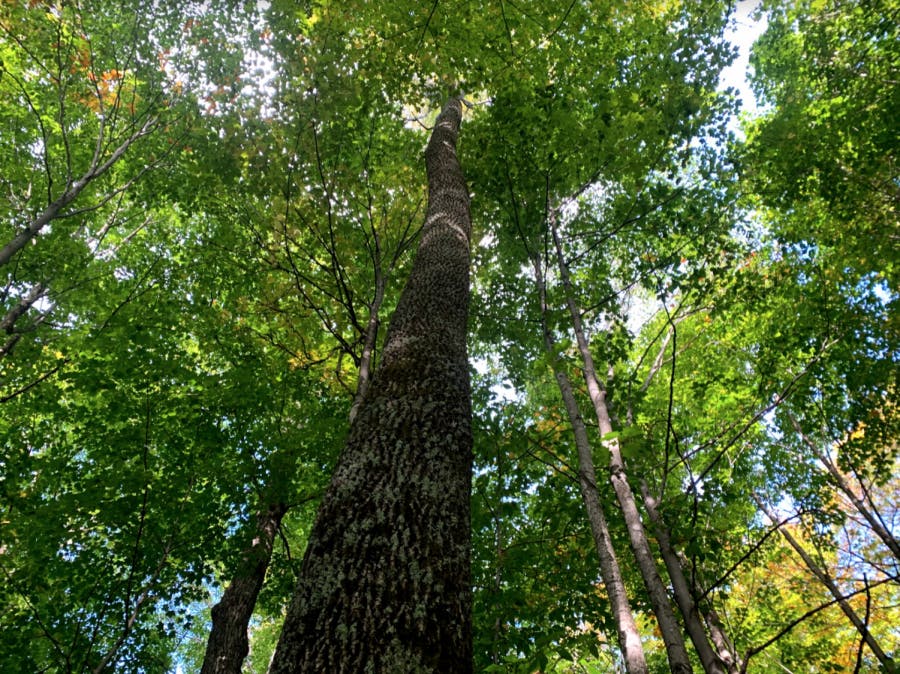“It’s like walking around a museum, looking at the few trees that survive.”
Jay Leshinsky, Middlebury’s first Garden Advisor, stands rooted to the lush Knoll on which he worked for 15 years. Throughout his time in the garden and long before, Middlebury’s ash trees have stood firmly and proudly along the Vermont hillside. Now, they are under threat of extinction. The culprit? The Emerald Ash Borer (commonly known as “EAB”), an invasive, deceptively beautiful green beetle that has, over the course of almost 20 years, extirpated America’s ash trees from much of the country.
The ash is one of the most common large trees in the northeastern United States. They can grow up to 115 feet tall (35 meters) and can live for up to 200 years, but you might know them from their “helicopter” seeds that spin their way to the ground each fall. The most common species in eastern Vermont is the White Ash; these trees tower over our campus and the town of Middlebury. They provide shade for students lounging outside of Davis, nesting sites for birds, which feed upon their fallen seeds, and respite for our campus’ beloved grey squirrels.
In a matter of years, these giants may be dead or entirely erased from Middlebury’s landscape.
The Emerald Ash Borer enters ash trees from openings in their bark and eats the inner tissues of the tree, destroying its channels for transporting water and nutrients. In less than four years, even the oldest and largest ash will die.
The beetle affects all eighteen US-native species of ash, as well as the White Fringe tree. It was first discovered in Detroit in 2001 and has since spread across the entirety of eastern North America, wiping out massive ash populations. Vermont is one of America’s last ash localities to be affected by EAB, the current range having spread through ten confirmed counties, including Addison.
Emmet Schmehling ’24 remembers finding afflicted ash branches in the woods around his childhood home in Caledonia, Michigan. Carved into each was a unique pattern of lines, bored into the wood by the vandal like a calling card.
“I always thought that they were some artifact from people long ago or a carving from somebody, not realizing what it actually was,” Schmeling said.
The state of Vermont is known to have been monitoring traps for EAB since 2013, according to Ginger Nickerson of the Vermont Urban and Community Forestry Program, an organization that works in conjunction with the University of Vermont and the local governments to educate the public about the state’s forests. EAB was first detected in central Vermont in December of 2018, and the state has since deployed several measures for monitoring the invasive pest. Most notably, condensed groups of ash trees have been inoculated against the beetle using an injected pesticide. This method, while effective, is not very feasible or practical when applied to larger ash stands.
Additionally, state officials have released parasitoid wasps in specified areas, which target EAB larvae. The wasps are part of a larger effort to combat the beetle using biocontrol, or the introduction of natural predators to eliminate a known pest. Although the EAB is not expected to be completely eradicated, the release of these wasps into more intensely affected areas has been effective in slowing its spread.
The crisis facing Middlebury’s ash trees is not a unique event. In particular, it is reminiscent of the American Chestnut blight, which all but eradicated the “Redwoods of the East'' in the early 1900s, and the Dutch Elm disease which continues to threaten America’s elms. Twenty-eight such elms stand firmly across Middlebury’s campus, maintained through regular inoculations. Part of Vermont’s, and possibly the East Coast’s, largest ongoing collection of old elms, some are over 90 feet tall and over 150 years old. There is no telling whether the methods used to protect the elms will prove to be effective in shielding our ash trees, but nonetheless efforts are being made to save these great environmental landmarks.
Tim Parsons points excitedly around campus from where he stands, outside McCullough Plaza.
“There’s one there… one there… a big one there,” he said.
Parsons has spearheaded Middlebury’s efforts against EAB since it first threatened campus 10 years ago. In the meantime, he has worked alongside the college and its students to map Middlebury’s ash population, marking those in “high risk” areas. If an ash tree is more than 25% dead, it becomes entirely unpredictable. It can break or fall over, so Parsons and his crew have no choice but to remove it. This is a major difference between ash and elm, Parsons explained. Elm is a strongwood, so it can be dead and stand for ten or twenty years without falling, whereas ash cannot be trusted to stay upright. Further, Parsons explained, elms are capable of reproducing long before they are susceptible to Dutch Elm disease, so we'll always have our elms. On the other hand, Parsons said that “EAB will kill an ash before it reaches a reproductive age, so we could very likely lose all of them.”
As bleak as this situation may seem, Middlebury does not plan to let its ash trees die without a fight.

“We have been talking about this for about 10 years now,” Parsons said, “About eight or nine years ago, the state of Vermont did a test plan for towns to use as a template to start to prepare for EAB. We took the draft of this plan and used it for the town of Middlebury, and about two years later, we used that same plan for our school.”
Of the two or three hundred ash trees on Middlebury’s campus, Parsons has inoculated 40 with a pesticide that kills EAB and prevents decay.
“For those forty trees, from what I’ve read it’s been really effective,” he said. “I do 20 trees each year and the inoculation lasts for two years, so I alternate. But those 20 trees take two, three, four days to do all of the injections, so to do all two or three hundred campus trees would just be huge. We just don’t have the resources to save all of them.”
A quick search of go/EAB will land you on a page with detailed maps and information about EAB and Middlebury’s ash trees. However, it hasn’t been updated in years.
“Like the rest of the school, we’re shorthanded in our department,” Parsons explained.
He remains the only person on campus with the pesticide license needed to inoculate the trees. Thinking ahead, Parsons imagines using the wood salvaged from downed ash trees as fuel for the school’s biomass plant, acknowledging that infested wood will be unusable and would have no commercial value.
“People don’t realize how much space these trees take up, so we need to plan ahead before they become a ‘problem,’” he said.
To this end, the Town of Middlebury recently received a grant from the state of Vermont to be used for the removal of ash trees and their replacement with 28 to 35 trees of various species.
“When ash dies, I don’t know if folks are prepared for what it will look like.”
A simple glance up at the Green Mountains on a fall day reveals a forest ablaze with a palette of reds and oranges, yellows and greens. In a couple of years, ten to fifteen percent of those trees will be grey, un-blossoming ghosts. We are in the calm before a violent storm that will permanently alter Vermont’s landscape, and the hills will be speckled with grey before long. On our own campus, ashes tend to stand in clusters, so although they account for only ten percent of our trees, their disappearance will seem much worse.
“I’m really scared about what might come into the holes that the ash will leave,” Parsons said. “In an ideal world, all of those holes will fill in with oak or sugar maple, or nice high-value trees. My fear is that all of these holes will get choked out by invasive plants and trees that you don’t want, and will spread from there.”
There is no saying exactly what will happen or how campus will respond to the arrival of the Emerald Ash Borer, but Parsons, backed by an abundance of passionate students, is determined to play his cards right.
“I’ve been yelling about this for years now. That’s my big takeaway: regardless of where I am on campus, I can point to an ash tree. It will have to come down,” he said.
Thanks to important work from people like Tim Parsons, Ginger Nickerson of the Vermont Urban and Community Forestry Program at UVM, and the Middlebury Tree Committee, Middlebury is prepared for the worst. For the protection and preservation of Middlebury’s Ash trees, it is necessary to detect the pest as soon as possible. Signs of EAB infestation include the emergence of adult green beetles in late May to early June, split bark, S-shaped tunnels behind the outer bark, D-shaped exit holes (about ⅛ inch wide) on the bark surface, woodpecker damage (often called “flecking”), dead top branches, and leafy offshoots from the lower trunk of the tree (per Town of Middlebury).
If signs of infestation can be seen, it’s advised to take photos and report the site to Vermont Invasives (VTInvasives.com). To prevent the spread of EAB, the state of Vermont advises against the transportation of firewood and infested ash wood. For more information on the Emerald Ash Borer, visit go/EAB, the Town of Middlebury, or the USDA online.

Charlie Deichman-Caswell ’24 (he/him) is a Photo Editor and Contributing Writer.
Charlie is an Environmental Studies major with a concentration in Anthropology, and French minor. He enjoys athletic activities such as climbing and soccer, as well as other hobbies like photography and creative writing. In his spare time, he enjoys hiking and spending time outdoors with friends, reading, watching movies, and generally chilling out.




